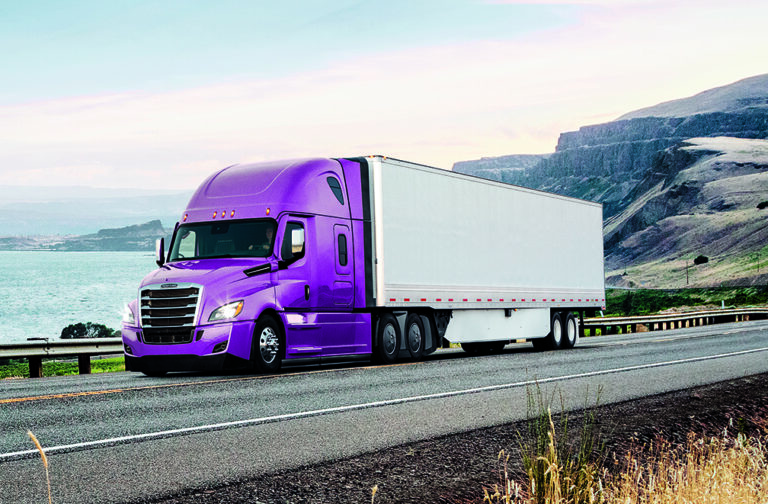U.S. sales of new Class 8 trucks remained strong in September with movement of 23,357 units reported by the manufacturers, according to data received from ACT Research. Compared with September of 2021, sales increased by 33%. September represented the fifth consecutive month of sales of over 20,000 units, after exceeding that threshold only once in 2021.
Sales numbers did decline some from August to September — by about 2.5% — a drop that could be attributed to having one less business day in the latter month.
Whatever the reason, it’s apparent the supply chain issues that plagued manufacturers for more than a year have abated somewhat.
Trucks are being built.
Orders for new trucks, which had fallen off earlier in the year, reached record levels in September as North American buyers ordered 53,700 new trucks. Some of the orders can be attributed to buyers canceling orders for 2022 models and replacing them with orders for 2023 models. Cancellations, however, remained low.
The demand for new trucks remains high, despite declining rates and inflationary pressures.
Another reason for the increased Class 8 orders could simply be timing.
“The strength in orders reflects OEMs’ having fully opened their order boards for 2023 a bit earlier than normal, as the seasonally weak period for truck orders typically runs May-September,” said Eric Crawford, vice president and senior analyst at ACT Research in an early October press release.
If it seems strange that carriers are ordering more trucks at a time when fuel costs are up and freight rates are declining … well, that’s because it IS strange. The trucking cycle seems to be in a weird exception to the usual process.
“We weren’t able to oversupply the market like we normally would have,” Crawford explained. “So, 2022 is less than it otherwise would have been.”
In a nutshell, what Crawford means is that when rates are up and freight is plentiful, carriers buy trucks while profits are easier to come by. The usual result is overcapacity — too many trucks to haul the available freight.
This time, however, carriers couldn’t buy all the trucks they wanted because the manufacturers couldn’t build enough. The result, for trucking, is that rates remained high for longer than they normally would. Spot rates have declined, but contract rates are just beginning to come down. The end result is that carriers are still making money.
“We expect (contract rates) to follow suit, but still, carriers are at near-record profitability, really healthy cash flow,” Crawford said. “We still we still think next year is going to be a pretty healthy year.”
Carriers that are earning profits tend to invest some of those profits into new equipment. According to Crawford, ACT predicts sales of 296,000 new Class 8 trucks next year.
New equipment provides another benefit: Newer trucks are generally equipped with the latest technology, providing better fuel mileage as well as improved safety due to ADAS (advanced driver assist systems) features on newer models.
The proverbial fly in the ointment, however, is unemployment.
“Unemployment hasn’t been lower than 3.5% since Neil Armstrong first set foot on the moon,” Crawford said. “We’re talking about a tight labor market and wage inflation. Wage inflation is the key driver for core inflation, and core inflation is what the Fed is trying to get rid of.”
While low unemployment numbers seem like a great thing, the law of supply and demand applies to labor, too. With workers harder to come by, businesses are more willing to raise wages to keep their workforce, often raising the prices of their products to compensate. This process pushes the inflation rate upward.
As for truck manufacturers, Freightliner sales of 8,395 Class 8 trucks on the U.S. market led all manufacturers in September, according to data received from Wards Intelligence. That number was down 1,388 trucks (14.2%) from August sales of 9,783, and was the largest decline by number of all manufacturers. Only tiny Western Star saw a larger decline by percentage, selling 392 trucks in September compared to 604 in August for a decline of 35.1%.
International saw results trending in the opposite direction, selling 3,848 trucks in September, a 40% increase over August sales of 2,749. Compared with September 2021, International sales rose by 1,768 trucks — a whopping 85%.
Volvo’s 2,432 trucks sold in September bested August sales of 2,243 by 8.4% and topped September 2021 sales of 1,713 by 42%. Volvo sibling Mack Trucks didn’t fare as well, with sales of 1,441 representing a decline of 9.6% from August sales of 1,594 — and a decline of 8.0% from September 2021 sales of 1,566.
Kenworth reported a 5% sales decline, with August sales of 3,310 dropping to 3,146 in September. Compared with September 2021, however, sales numbers increased 19.8%. PACCAR sibling Peterbilt sold 3,317 Class 8 trucks on the U.S. market in September, rising 0.6% from 3,298 in August and showing an impressive 73.7% gain over September 2021 sales of 1,910.
On a market share basis, Freightliner holds 38.1% of 2022 sales, down slightly from 38.3% at the same point last year, despite selling 5,695 more trucks.
Peterbilt is next, with 15.1% compared to 14.8% at the same point last year. Kenworth is at 14.2% of U.S. Class 8 sales year to date, down from 14.8% at the same time last year, even though the manufacturer sold 1,207 more trucks.
International is next with 12.4% of the Class 8 market, down from 12.6% at the same point last year but improved, with strong sales in the last several months. Volvo commands 11% of this year’s market, an improvement from 8.8% at the same point of 2021. Mack owns 6.3%, down slightly from 6.5% after the first three quarters of 2021.
As a whole, the U.S. Class 8 market is 9.6% ahead of last year’s pace at the end of September and is performing better than predicted earlier in the year.
As pundits continue to discuss an economic recession in the first half of 2022, Class 8 truck sales should continue to buck the trend by increasing. Lower freight rates, however, have already pushed more used trucks to the market, increasing the supply and beginning to push prices downward.
Cliff Abbott is an experienced commercial vehicle driver and owner-operator who still holds a CDL in his home state of Alabama. In nearly 40 years in trucking, he’s been an instructor and trainer and has managed safety and recruiting operations for several carriers. Having never lost his love of the road, Cliff has written a book and hundreds of songs and has been writing for The Trucker for more than a decade.















